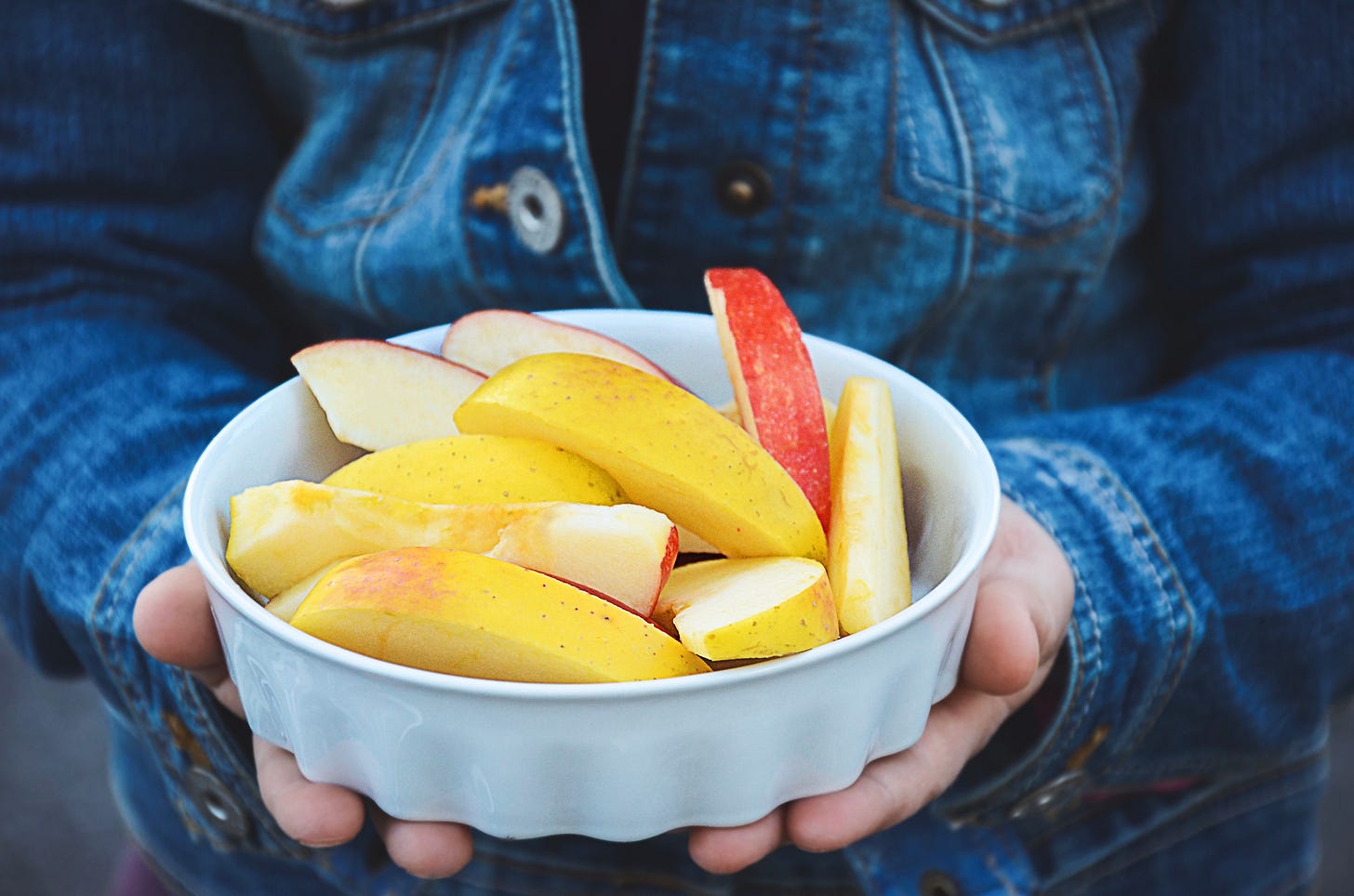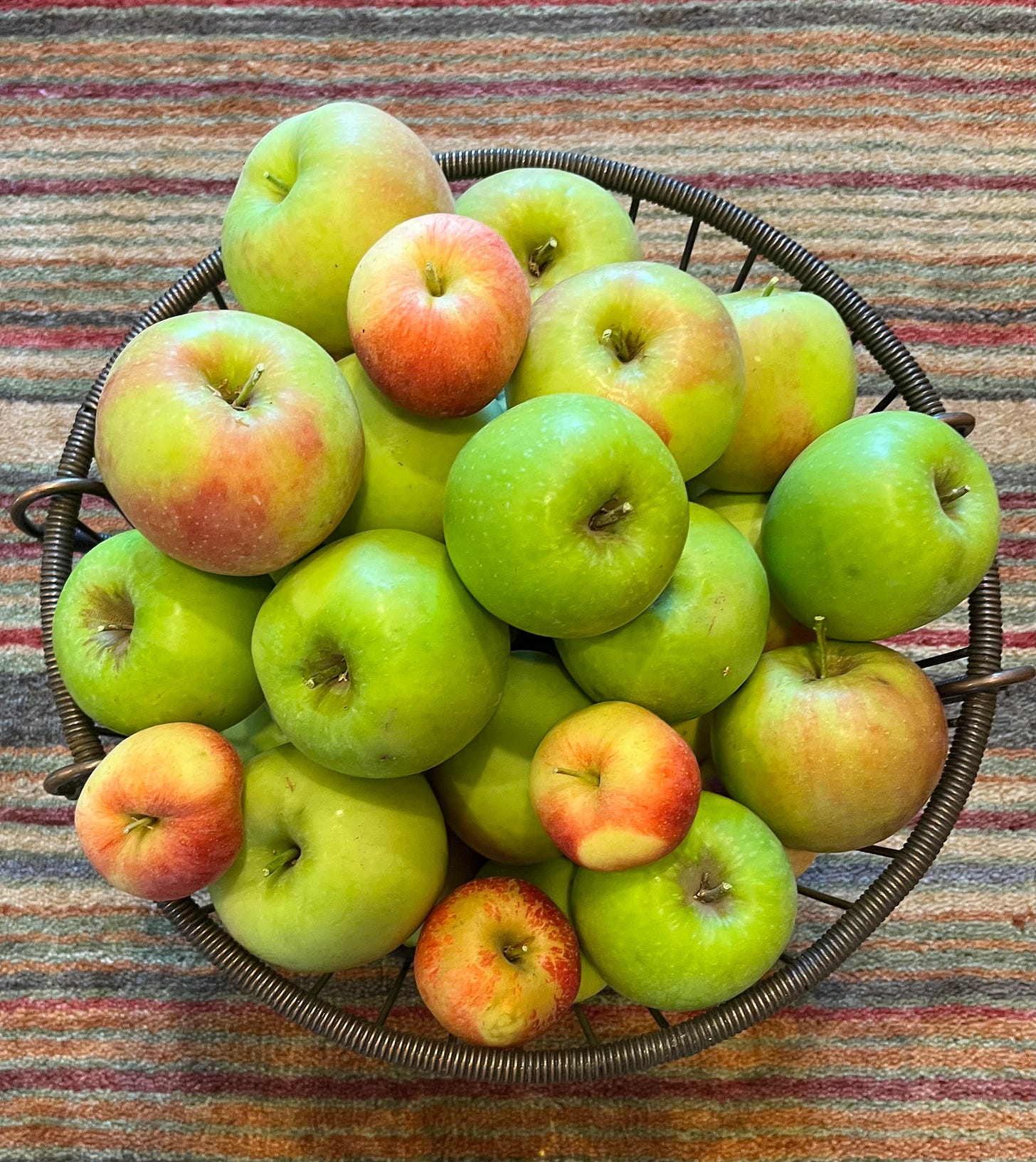One Flavor, Six Paths: Apple
Apple can calm your mealtime frustration while guiding your child toward confidence with food.
Familiar, bright, and comforting – apple often marks a child’s first confident relationship with flavor.
Apple’s gentle sweetness guides your child toward calm, confident eating.
Long before apples found their way into lunchboxes, they carried a deeper meaning. In early American history, families often gave apples as payment for a child’s education. This gesture later became a child giving an apple to a teacher as a symbol of appreciation and shared learning. Across cultures and centuries, the apple has symbolized wisdom, goodness, and health. Think of the “tree of knowledge” and “an apple a day keeps the doctor away.”
From a child’s first purée to crunchy slices tucked into lunch, apple invites children to trust food. It is bright, familiar, and endlessly adaptable. Apple is a flavor that feels like home in almost any form. It appears early in a child’s eating journey because familiar flavors build trust, which is the first step in flavor learning.
Maybe it’s the crunch you hear, that crisp sound when your child bites into a slice, or the soft comfort of warm applesauce on a chilly morning. However it appears, apple often marks a child’s first confident relationship with flavor. That familiarity becomes your gentle invitation to guide your child toward more complex tastes.
Apple’s story extends far beyond the snack table. In kitchens around the world, apple carries sweetness into savory. In Spain, apple is cooked with paprika and oil to glaze pork. In rustic French soups, apples are simmered with onions to soften the aromatics. In Japan, a touch of apple is stirred into miso for vegetables or fish. Apple is not a simple, boring fruit. It’s a flexible foundation for flavor-building. Using apple as a foundation helps your child feel safe as flavors evolve and grow more complex.
For your child, this same pairing principle applies. Apple’s natural sweetness helps scaffold your child’s trust to taste new savory flavors. Sweetness signals familiarity to the brain. Familiarity relaxes the palate. A relaxed palate is more open to trying new flavors. Apple is a recognizable flavor that can guide your child’s taste literacy.
As we shared in our previous Leek and Potato Flavor Pathways, taste literacy is a step-by-step approach that guides your child to confidence with new foods. Taste literacy scaffolds your child’s food confidence through flavor and texture, one step at a time. It’s not about recipes, one-more-bite struggles, or your child’s age or intake. Taste literacy is the developmental process by which children learn to understand, accept, and enjoy flavor. Just as your child builds reading fluency step by step, from letters to words to sentences to stories, they grow taste fluency through gentle, repeated encounters with flavor.
Apple is a familiar flavor and trusted starting point, a calm place from which you can guide your child toward curiosity and confidence at the table.
Apples from my garden – a reminder that familiar flavors often hold the first lessons in trust and curiosity.
Why This Flavor Matters
From the very beginning of life, sweetness signals safety. Breast milk is slightly sweet. Fruit is sweet. That is why children accept sweetness without hesitation. It feels familiar and safe. Savory and bitter flavors, however, require learning. Apple helps guide that learning by blending trust and challenge in one gentle bite.
Because children have more taste buds than adults, they experience sweet and sour flavors more intensely. This heightened sensitivity can make new flavors feel strong or even too much. When sweetness is paired with soft savory notes, like leek, sage, or thyme, the brain learns that complexity can still feel calm.
This process is called gustatory priming: using comfort to prepare the palate for variety, one calm pairing at a time.
By gradually shifting a food’s flavor balance, from mostly apple with a hint of savory, to half apple and half savory, and eventually to mostly savory, you help your child’s palate pave new sensory pathways. Instead of bracing against unfamiliar tastes, your child begins to recognize, “This is apple… and another flavor.” Over time, that “other flavor” becomes familiar, too.
Apple matters because it:
Invites calm exploration through sweetness. Its gentle profile helps your child feel safe while noticing change.
Supports flavor layering and gentle progression. Combining apple with mild aromatics or herbs allows new flavors to feel connected, not separate.
Encourages sensory curiosity. Sweetness makes space for noticing aroma, warmth, and texture in small, trusted steps.
Builds cross-sensory awareness. As apple shifts from crisp to soft, from cool to warm, your child learns that flavor is more than taste. It is sound, smell, and memory intertwined.
From purée to curiosity – even the first spoonful builds early trust with flavor.
Pediatric Culinary Medicine Insight
From a pediatric culinary medicine perspective, apple demonstrates how taste literacy develops, through gentle contrast, calm repetition, and sensory exposure that feels safe.
Sweetness as an anchor. Apple creates safety, allowing the brain to focus on the new element without stress.
Gradual flavor balance. Start with mostly apple and just a hint of savory flavor, for example, warm apple purée with a touch of sautéed leek or sweet potato. Over time, adjust the balance so there is a little less apple and a bit more savory. These small, steady changes stretch your child’s comfort zone while keeping exploration calm and connected.
Neuro-flavor mapping. Every calm, balanced bite strengthens your child’s internal library of trusted tastes. A sweet beginning becomes the scaffold for exploring savory flavors later.
Cooking deepens that learning. Lightly browning apple in butter caramelizes its natural sugars, creating warm aromas that connect to future flavor memories, like roasted vegetables or baked squash. Mixing grated apple into lentils or blending it into soup provides early exposure to umami notes within a familiar, trusted context.
Each variation builds palate flexibility and culinary curiosity, for your child and for you.
Apple reminds us that confidence does not come from removing comfort, but from using it intentionally as the pathway forward.
Levels of Flavor Confidence
By now, you may already recognize the three levels that guide every Flavor Pathway. Each level reflects where your child feels most comfortable meeting new tastes, according to their confidence level, not their age.




